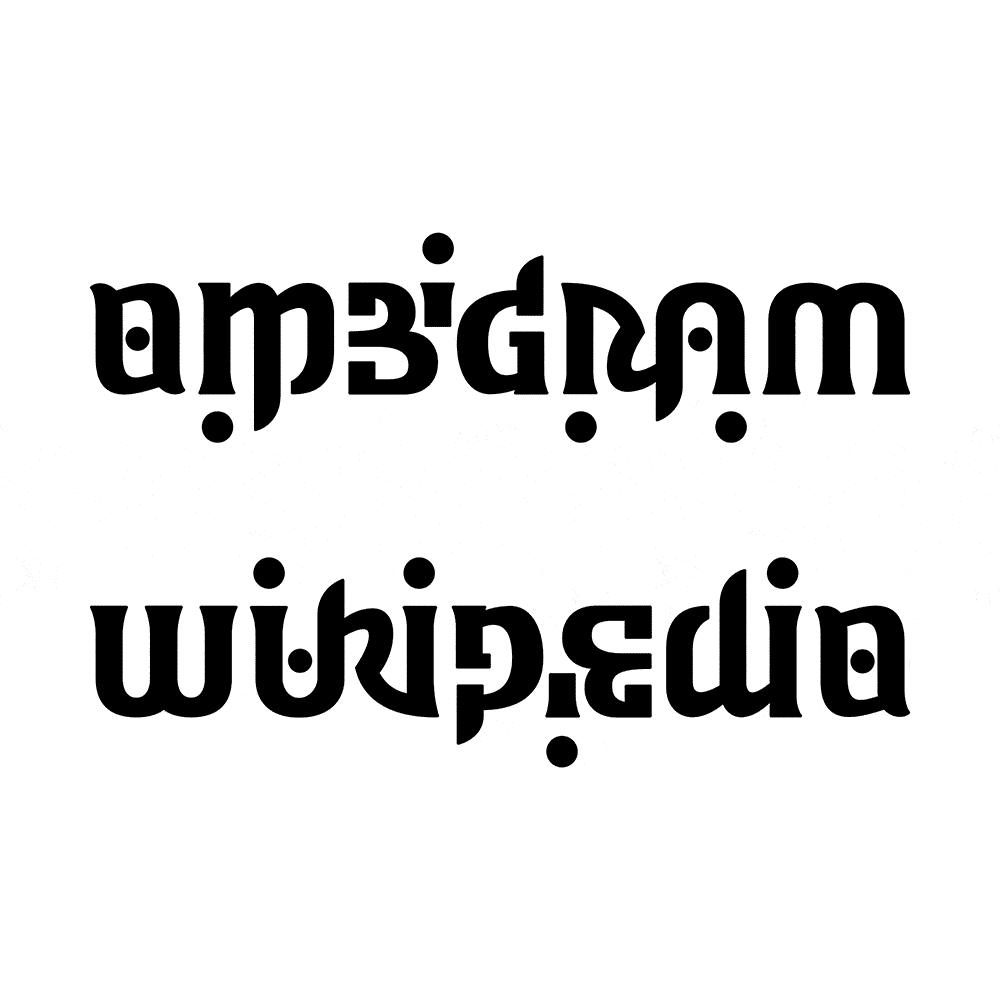Have you ever seen a word or design that reads the same upside down or backward? This fascinating art form is called an ambigram, a unique blend of creativity and symmetry that captivates both the mind and eye. Ambigrams have gained immense popularity in recent years, but their history and significance run much deeper. Understanding what an ambigram is and how it works can unlock a world of possibilities for artists, designers, and typography enthusiasts alike.
Ambigrams are not just mere designs; they are a testament to human ingenuity and creativity. By combining mathematical precision with artistic flair, these designs create optical illusions that challenge our perception of words and symbols. Whether you're a graphic designer or simply someone who appreciates the beauty of language, ambigrams offer a unique way to explore the intersection of art and science.
In this article, we will delve into the world of ambigrams, exploring their history, types, applications, and the creative process behind their creation. By the end, you'll have a deeper understanding of this fascinating art form and how it continues to inspire creativity across various fields.
Read also:Cerritos Mall Black Friday Hours Your Ultimate Guide To Shopping
Table of Contents
- Introduction to Ambigram
- History of Ambigram
- Types of Ambigram
- Creating an Ambigram
- Applications of Ambigram
- Famous Ambigram Artists
- Benefits of Ambigram
- Ambigram in Popular Culture
- Tools for Creating Ambigram
- Future of Ambigram
Introduction to Ambigram
An ambigram is a typographical design that can be read in more than one way or from more than one perspective. These designs often incorporate symmetry, rotation, or reflection to create words or phrases that maintain their legibility when viewed from different angles. Ambigrams are not just artistic expressions; they are a form of intellectual play that challenges the viewer's perception and understanding of language.
At its core, an ambigram combines elements of art, mathematics, and linguistics. The creator must carefully balance the aesthetic appeal of the design with the functional requirement of readability. This dual nature makes ambigrams a fascinating subject for both creators and admirers.
History of Ambigram
The origins of ambigrams can be traced back to ancient civilizations, where symmetry and balance were often used in art and architecture. However, the modern concept of ambigrams as we know it today began to take shape in the late 20th century. Artists like Scott Kim and John Langdon played pivotal roles in popularizing this art form.
Early Beginnings
While the term "ambigram" was coined in the 1970s, the concept of reversible designs has existed for centuries. Early examples can be found in palindromes, where words or phrases read the same backward as forward. Over time, artists began experimenting with more complex designs, incorporating rotation and reflection to create multi-directional readings.
Modern Evolution
In the 1980s and 1990s, ambigrams gained widespread recognition, thanks to the work of pioneers like Scott Kim, whose puzzles and designs captivated audiences worldwide. Today, ambigrams are used in everything from corporate logos to tattoos, showcasing their versatility and appeal.
Types of Ambigram
There are several types of ambigrams, each with its own unique characteristics and techniques. Understanding these variations can help you appreciate the complexity and creativity involved in creating these designs.
Read also:Understanding Food Stamp Number A Comprehensive Guide To Snap Benefits
Rotational Ambigrams
Rotational ambigrams are designed to be read the same way when rotated 180 degrees. This type of ambigram relies heavily on symmetry and careful letter design to ensure readability from both orientations.
Mirror Ambigrams
Mirror ambigrams are created by reflecting the design along a vertical or horizontal axis. These designs often require precise alignment of letters to maintain legibility when viewed from both sides.
Stacked Ambigrams
Stacked ambigrams combine multiple layers of text to create designs that can be read in different directions or perspectives. This type of ambigram often requires advanced techniques and planning to execute successfully.
Creating an Ambigram
Creating an ambigram is a process that requires both creativity and technical skill. Artists must carefully consider the balance between aesthetics and functionality, ensuring that the design remains legible while maintaining its artistic integrity.
Steps to Create an Ambigram
- Choose the word or phrase you want to transform into an ambigram.
- Decide on the type of ambigram you want to create (rotational, mirror, etc.).
- Sketch out initial designs, focusing on symmetry and letter alignment.
- Refine the design, making adjustments to ensure readability from all intended perspectives.
- Digitize the final design using graphic design software for professional results.
Applications of Ambigram
Ambigrams have found applications in various fields, ranging from art and design to marketing and branding. Their unique ability to convey multiple meanings makes them a powerful tool for communication and expression.
Corporate Logos
Many companies use ambigrams in their logos to convey a sense of balance and innovation. These designs often reflect the brand's values and mission, making them memorable and impactful.
Tattoos and Personal Art
Ambigrams are increasingly popular as tattoo designs, offering individuals a way to express their personal identity through symmetry and creativity. Their ability to convey multiple meanings makes them a favorite among tattoo enthusiasts.
Famous Ambigram Artists
Several artists have made significant contributions to the world of ambigrams, pushing the boundaries of this art form and inspiring countless others. Here are some of the most notable names in the field:
- Scott Kim: Known for his puzzle designs and reversible typography, Scott Kim is often credited with popularizing ambigrams in the modern era.
- John Langdon: A pioneer in the field, John Langdon has created numerous iconic ambigram designs, including the famous "Art of Illusion" logo.
- Scott Kim: His work in reversible puzzles and designs has earned him recognition as one of the leading figures in the ambigram community.
Benefits of Ambigram
Ambigrams offer a range of benefits, both practical and aesthetic. They encourage creativity, challenge perception, and provide a unique way to communicate complex ideas.
Enhancing Cognitive Skills
Creating and interpreting ambigrams can improve cognitive skills such as problem-solving, spatial awareness, and pattern recognition. These abilities are valuable in many fields, from art and design to science and engineering.
Artistic Expression
Ambigrams provide artists with a versatile medium for self-expression, allowing them to explore themes of symmetry, balance, and duality. Their ability to convey multiple meanings makes them a powerful tool for storytelling and communication.
Ambigram in Popular Culture
Ambigrams have made appearances in various forms of media, including movies, books, and advertisements. Their unique visual appeal and intellectual challenge make them a popular choice for creators looking to captivate their audience.
Film and Television
Several films and TV shows have featured ambigrams as part of their visual storytelling. For example, the movie "Inception" used an ambigram in its promotional materials to highlight the film's themes of perception and reality.
Advertising
Companies often incorporate ambigrams into their advertising campaigns to create memorable and engaging visuals. These designs help capture the viewer's attention and convey complex messages in a concise and impactful way.
Tools for Creating Ambigram
While traditional methods of sketching and refining designs are still popular, modern technology has introduced a range of tools to assist in the creation of ambigrams. These tools can help artists streamline the design process and achieve professional results.
Graphic Design Software
Software like Adobe Illustrator and Photoshop are commonly used by artists to create digital ambigram designs. These programs offer advanced features for editing and refining designs, making them an essential part of the creative process.
Online Generators
Several online tools and generators are available for those interested in creating ambigrams without extensive design experience. While these tools may not offer the same level of customization as professional software, they provide a great starting point for beginners.
Future of Ambigram
The future of ambigrams looks promising, with advancements in technology and design tools opening up new possibilities for this art form. As more people discover the beauty and complexity of ambigrams, their popularity is likely to continue growing, inspiring new generations of artists and designers.
Integration with Technology
With the rise of augmented reality and virtual reality, ambigrams may find new applications in interactive media, offering users immersive experiences that challenge their perception and understanding of language.
Global Recognition
As ambigrams gain recognition worldwide, they are likely to be incorporated into various cultural and artistic expressions, further enriching their significance and appeal.
Conclusion
Ambigrams are a testament to human creativity and ingenuity, offering a unique way to explore the intersection of art and science. From their humble beginnings in ancient civilizations to their modern applications in branding and advertising, ambigrams continue to captivate and inspire people across the globe.
We encourage you to explore this fascinating art form further by experimenting with your own designs or learning more about the artists who have shaped its evolution. Don't forget to share your thoughts and experiences in the comments below, and consider exploring other articles on our site for more insights into the world of typography and design.



